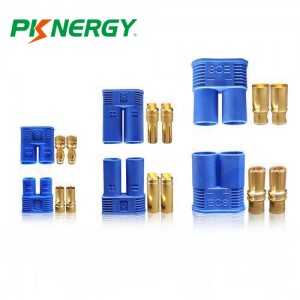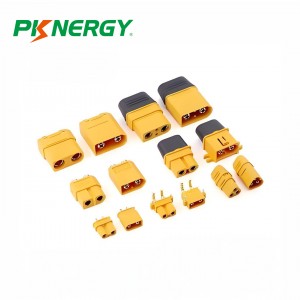LiPo-Akku-Anschlüsse gehören zu den wichtigsten Komponenten von Lithium-Polymer-Akkus. Ein gutes Verständnis dieser Anschlüsse hilft Anwendern bei der Auswahl der richtigen Verkabelung für optimale Leistung. Dieser Artikel untersucht die verschiedenen LiPo-Akku-Anschlüsse und zeigt, wie man den besten auswählt.
Welche Rolle spielt ein LiPo-Batterieanschluss?
A LiPo-Batterieanschlussgewährleisteteffiziente und sichere Stromübertragungzwischen Akku und Gerät. Der Stecker beeinflusst die Kontaktqualität zwischen Akku und Gerät und bestimmt den maximal unterstützten Strom.
Welche Arten von LiPo-Batterieanschlüssen gibt es gängig?
Zu den gängigen Typen von LiPo-Batterieanschlüssen gehören:
- XT-Serie (XT30, XT60, XT90)
- EC-Serie (EC3, EC5, EC8)
- JST-Anschluss
- Deans T-Verbinder
- JR-Anschluss
Diese Steckverbinder bieten je nach aktuellen Anforderungen und Geräteschnittstellenkompatibilität unterschiedliche Eigenschaften.
Unterschiede zwischen LiPo-Batterieanschlüssen
Verschiedene LiPo-Akku-Anschlüsse unterscheiden sich in Stromkapazität, Anschlussdichte und Größe. Zum Beispiel:XT-Anschlüssehaben eine höhere Stromkapazität und sind für Hochleistungsgeräte geeignet, währendJST-Steckverbinderwerden aufgrund ihrer kompakten Größe in Anwendungen mit geringerer Leistung eingesetzt.
Warum haben LiPo-Akkus zwei Anschlüsse?
LiPo-Akkus haben in der Regel zwei Anschlüsse – einen fürEntladen(Stromversorgung des Geräts) und eine weitere fürLaden(Anschluss für Ausgleichsladegerät). Der Ladeanschluss sorgt für eine konstante Spannung aller Zellen und erhöht so die Sicherheit und Lebensdauer der Batterie.
Was ist der Unterschied zwischen den LiPo-Batterieanschlüssen EC3, EC5 und EC8?
- EC3: Geeignet für Anwendungen mit niedrigerem Strombedarf, mit einer Kapazität von ca.60A.
- EC5: Größer, unterstützt bis zu120Afür Mittelstromanwendungen.
- EC8: Für hohe Leistungsanforderungen konzipiert, mit Strömen über200A.
Was ist der Unterschied zwischen JR- und JST-LiPo-Batterieanschlüssen?
- JR-Steckverbinder: Werden normalerweise für Empfänger und Servoverbindungen verwendet, unterstützen niedrigere Ströme, bieten aber stabilen Kontakt.
- JST-Steckverbinder: Kompakt und weit verbreitet in Mikrogeräten und Schwachstromanwendungen, wie zum Beispielkleine DrohnenUndRC-Autos.
Was ist der Unterschied zwischen den LiPo-Batterieanschlüssen XT30, XT60 und XT90?
- XT30: Ideal für kleine Geräte mit einem maximalen Strom von30A.
- XT60: Geeignet für Geräte mittlerer Leistung, bis zu60A.
- XT90: Entwickelt für Hochleistungsgeräte mit einer maximalen Kapazität von über90A.
Wählen Sie den passenden XT-Anschluss basierend auf dem Strombedarf Ihres Geräts.
Wie wähle ich den richtigen LiPo-Batterieanschluss aus?
Die Wahl des richtigen LiPo-Akkuanschlusses ist entscheidend für die Sicherheit und Effizienz Ihrer elektronischen Geräte oder Projekte. Hier sind einige hilfreiche Schritte:
- Identifizieren des Geräts oder der Anwendung: Bestimmen Sie die Spannung, den Strom und die physikalischen Einschränkungen Ihres Geräts.
- Spannungs- und Stromanforderungen: Stellen Sie sicher, dass der Stecker die Spannung und den Strom ohne Überhitzung bewältigen kann.
- Steckertyp: Wählen Sie den entsprechenden Anschlusstyp (z. B.JST, Molex, Hirose, XT60), das mit Ihrem Akku und Gerät kompatibel ist.
- Polaritätsanpassung: Achten Sie auf die richtige Polarität, um Schäden oder Sicherheitsrisiken zu vermeiden.
- Größe und Form des Steckverbinders: Stellen Sie sicher, dass der Stecker gut in das Gerät passt.
- Verriegelungsmechanismus: Wählen Sie Steckverbinder mit Verriegelungsfunktionen für Anwendungen mit Vibrationen.
- Verfügbarkeit: Wählen Sie Anschlüsse, die leicht zu beschaffen sind.
- Einfache Montage: Bedenken Sie, wie schwierig das Löten oder Installieren des Steckers ist.
- Haltbarkeit und Qualität: Investieren Sie in hochwertige Steckverbinder für eine längere Lebensdauer und Zuverlässigkeit.
- Kompatibilität: Bestätigen Sie die Kompatibilität mit Akku und Gerät.
Wenn Sie sich nicht sicher sind, welchen Anschluss Sie wählen sollen, wenden Sie sich an PKNERGY. AlsHersteller von Lithium-Polymer-BatterienPKNERGY verfügt über umfangreiche Erfahrung in der Entwicklung von LiPo-Batterielösungen für verschiedene Spezifikationen und Branchen.
Abschluss
LiPo-Akku-Steckverbinder spielen eine entscheidende Rolle für die zuverlässige Stromübertragung zwischen Akku und Gerät. Verschiedene Steckverbinder erfüllen unterschiedliche Stromanforderungen und Gerätetypen. Beachten Sie bei der Auswahl des richtigen Steckverbindersaktuelle Kapazität, Gerätekompatibilität, UndSteckergröße/Gewichtum optimale Geräteleistung und Verbindungszuverlässigkeit zu gewährleisten. Wenn Sie die Eigenschaften verschiedener Steckertypen kennen, können Sie die beste Lösung für den Strombedarf Ihres Geräts auswählen.
Veröffentlichungszeit: 23. Oktober 2024


